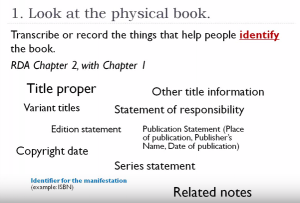RDA Chapter 2 (with Chapter 1)
Look at the physical book.
RDA Chapter 3.
Look at the physical book again. n.b. for a book, carrier type is volume; extent is number of pages; font size is a separate piece of data so gets a separate element in RDA
RDA Chapter 4.
Consider the book in terms of acquisition and access. e.g. contact information includes address or website of publisher
Summary so far – with example:
Note: when RDA uses “transcribe” vs “record” there are requirements in place for how the text is to be presented. This is standard across the elements.
Next: moving away from the physical item and into the work and expression.
RDA Chapter 6 (with Chapter 5).
Consider the content of the book. Some GMD information is included here.
Now… Chapter 6 deals with the Authorised Access Point for the work. Instructions for main entry are found at the end of Chapter 6.
Authorised Access Point – a unifying heading that helps identify that specific work. Note the order of the name, the punctuation and the birth – death year information.
RDA Chapter 7 (with Chapter 5).
RDA Chapters 9, 10 and 11 (with Chapter 8).
RDA Chapter 17
General Guidelines on Recording Primary Relationships. n.b. some primary relationships have to be inferred ;(
RDA Chapters 19, 20, 21 and 22 (with Chapter 18)
Top level relationships:
RDA asks for more information about the relationship between the work and the people.
Example of mapping RDA roles:
Note in example that composer is also a singer so is listed in the different roles… RDA maps all these relationships out.
RDA Chapters 25, 26, 27 and 28 (with Chapter 24)
includes series part because this is about the relationship between this book and others in the series
RDA gathers all the information together – it does not dictate what that information will look like in a specific record in a catalogue. Here is an example
Structured descriptions example
Unstructured descriptions example
RDA Chapters 30, 31 and 32 (with Chapter 29)
N.B. Chapters 12-16 are place holder chapters with some information filled in. e.g. formatting geographic names
Summary
References:
Brenndorfer, T. (2012) RDA in 10 easy steps. [online]. Available at
www.youtube.com/watch?v=D3hafSNH_3A





















